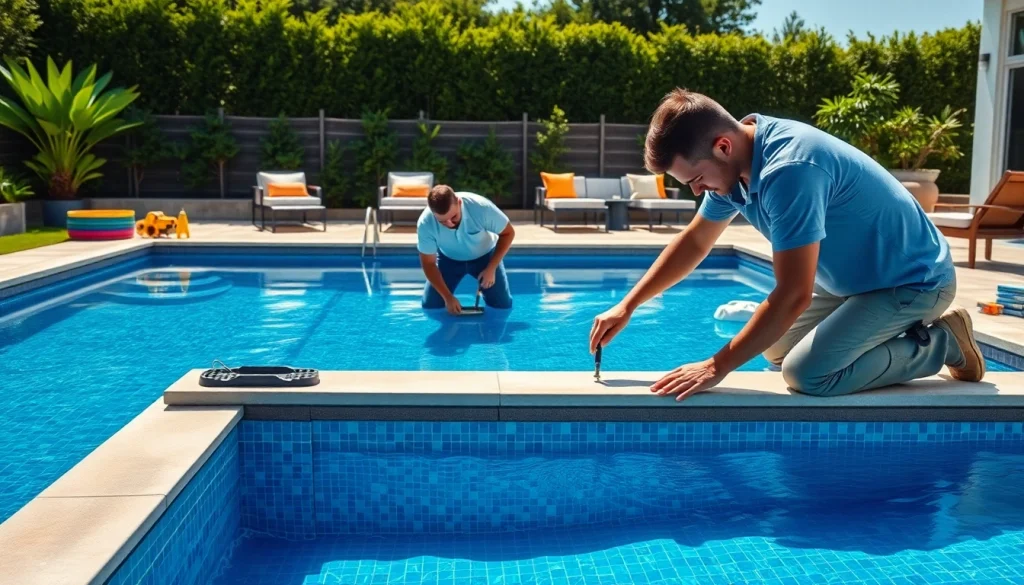Expert Swimming Pool Installation: What You Need to Know for Your Backyard Oasis

Understanding Swimming Pool Installation Basics
Installing a swimming pool is a significant investment and endeavor that can enhance the value of your home while providing a wonderful space for relaxation and recreation. Whether you’re interested in a serene inground pool surrounded by lush landscaping or a convenient above-ground pool for family fun, understanding the essentials of swimming pool installation is crucial. In this section, we will break down the basics, including the types of swimming pool materials available, the key steps in the installation process, and how to choose the optimal location for your pool.
Types of Swimming Pool Materials
Choosing the right material for your pool is fundamental, as it influences not only the aesthetic and functional aspects but also the overall cost and durability. The most common swimming pool materials include:
- Concrete: Known for its durability and customization options, concrete pools can take any shape and offer a wide range of finishes. However, they require significant time for installation and can be more expensive than other options, with costs ranging from $35,000 to $120,000.
- Fiberglass: Prefabricated fiberglass pools are known for their simplicity in installation and lower maintenance requirements. Their cost typically ranges from $20,000 to $85,000, making them a popular choice.
- Vinyl: Utilizing a vinyl liner within a wall structure, these pools are among the most affordable, ranging from $20,000 to $40,000. They require liner replacements every 5-9 years, adding to long-term costs, but they provide a smooth surface that can be easier on the skin.
- Above-Ground Pools: Generally the most budget-friendly option, above-ground pools can range from as little as $1,000 to $10,000, depending on size and materials. However, they may lack the aesthetics of in-ground options and usually have a shorter lifespan.
Key Steps in the Installation Process
The installation process of a swimming pool involves several important steps:
- Planning and Designing: Define the type and size of the pool, layout, and any additional features like decks or spas.
- Permitting: Check local regulations and acquire necessary building permits for the installation process.
- Site Preparation: This involves clearing the area for the pool, leveling the ground, and marking pool dimensions.
- Excavation: Dig the hole for the pool according to the chosen design and specifications.
- Installing the Structure: Depending on the material chosen, install the pool’s structure – this could involve pouring concrete, placing fiberglass shells, or erecting the walls for vinyl pools.
- Plumbing and Electrical Work: Set up filtration systems, pumps, and lighting, ensuring all electrical components meet local codes.
- Finishing Touches: Add finishes, coping, decks, and landscaping. Finally, fill the pool with water and balance chemicals.
Choosing the Right Location
Site selection is crucial for your pool’s installation. Consider the following factors:
- Sun Exposure: A pool in a sunny location will stay warmer and be more enjoyable for swimming.
- Accessibility: Assess how easily you and your guests can access the pool area and any accompanying features, like bathrooms or changing rooms.
- Proximity to Trees: While trees provide shade, they can also drop leaves and debris into the pool. A balance is needed.
- Natural Drainage: Choosing a spot with good drainage will minimize water pooling issues after rain.
- Local Regulations: Ensure that your chosen location complies with all local building codes and setback requirements.
Cost Considerations for Swimming Pool Installation
Understanding the financial implications of a swimming pool installation will help you set a realistic budget and avoid unexpected expenses. The costs can vary widely based on the type of pool, geographical area, and additional features you wish to include.
Factors Affecting Installation Costs
Several key factors can significantly influence the overall cost of pool installation:
- Type of Pool: As mentioned earlier, the material used has the biggest impact on price.
- Size and Depth: Larger or deeper pools will typically require more materials and labor, increasing costs.
- Additional Features: Features like waterfalls, integrated spas, LED lighting, or saltwater systems add to both the upfront costs and ongoing maintenance.
- Landscaping: Don’t forget to include costs for landscaping around the pool, which can enhance the overall aesthetic.
- Labor and Contractor Fees: Costs of hiring experienced professionals for installation can vary based on location and labor market.
Budgeting for Your Backyard Pool
When budgeting for your swimming pool installation, consider the following strategies:
- Initial Investment: Start with the base cost estimates for the pool type you prefer and create a detailed list of all additional expenses.
- Maintenance Costs: Include estimates for ongoing maintenance, water treatment, and potential repairs over the next few years.
- Future Upgrades: Consider setting aside a budget for future enhancements or upgrades that you’ll want down the line.
Financing Options for Pool Installation
There are various options for financing your swimming pool:
- Personal Loans: Many homeowners opt for personal loans with fixed rates to cover pool installation costs.
- Home Equity Loans: If you’ve built equity in your home, this option can be an affordable way to access funds for your pool.
- Pool Financing Programs: Some pool contractors offer financing plans specifically tailored for pool installation.
- Credit Cards: High-limit credit cards may be a viable option for covering costs, but be mindful of interest rates.
Choosing the Right Contractor for Pool Installation
Finding the right contractor is critical to the success of your pool installation. The expertise and experience of your contractor can make all the difference in achieving the pool of your dreams.
Factors to Consider When Hiring
When selecting a contractor, consider these essential factors:
- Experience and Reputation: Research their years in business and their reputation in the community.
- Licensing and Insurance: Ensure they possess the necessary licenses and insurance to operate in your area.
- Portfolio of Past Work: Look at previous projects to determine their design style and quality of workmanship.
Questions to Ask Your Pool Installer
To ensure you’re partnering with a reputable contractor, ask the following questions:
- What is your estimated timeline for this project?
- Can you provide references from past clients?
- What is included in your quoted price, and are there any potential additional charges?
- Do you offer warranties on your work or the materials used?
Reading Reviews and Testimonials
Review platforms, social media, and contractor websites can provide valuable insights into client satisfaction. Be sure to look for:
- Overall ratings and feedback consistency.
- Specific testimonials regarding project execution and aftercare.
- Photos and descriptions of completed installations to evaluate expertise.
Benefits of Professional Swimming Pool Installation
Ultimately, choosing to invest in professional swimming pool installation rather than attempting a DIY project can yield numerous benefits that enhance your overall experience.
Quality Assurance and Longevity
Professional installers have the experience needed to ensure precision in construction, reducing the risks of future repairs or maintenance issues.
Design Expertise and Custom Features
Hiring a professional means access to expert designers who can tailor the layout and features of your pool to meet your specific desires while maximizing the functionality of your backyard space.
Regulatory Compliance and Safety
Professionally installed pools comply with local building codes and safety standards, which can save you from potential legal issues or unsafe construction practices down the line.
Maintenance and Care After Installation
Ongoing maintenance is critical in prolonging the life of your pool and ensuring it remains a safe and enjoyable environment for all users. Understanding the maintenance requirements can help you stay on top of care tasks.
Essential Maintenance Tips for Longevity
To keep your pool in top condition, incorporate the following maintenance practices:
- Regular Cleaning: Skim debris off the surface, vacuum the bottom, and maintain clean filters to ensure optimal water quality.
- Water Testing: Test the water regularly to maintain the proper chemical balance, which is crucial for swimmer safety and pool integrity.
- Winterization: If you live in a climate with freezing temperatures, winterize your pool properly to prevent damage during colder months.
Pool Repair Services and When to Use Them
Despite good maintenance practices, pool issues can arise. Quick action can save costly repairs:
- Identify cracks in the pool surface or walls that might need immediate attention.
- Monitor for leaks in the plumbing system, which can lead to water loss and higher bills.
- Watch for signs of equipment failure, such as unusual noises or inadequate water circulation.
Upgrades and Enhancements Post-Installation
As trends evolve and new technology surfaces, consider potential upgrades to your pool space:
- Energy-Efficient Systems: Invest in pumps and heaters that lower operational costs while maintaining performance.
- Smart Technology: Incorporate smart controls for lighting and temperature for added convenience.
- Water Features: Enhance the aesthetic appeal by adding fountains, waterfalls, or integrated lighting designs.







